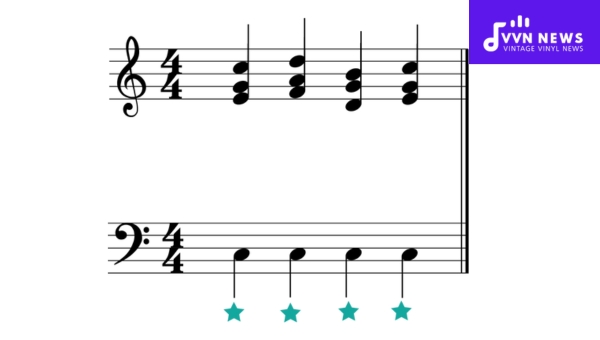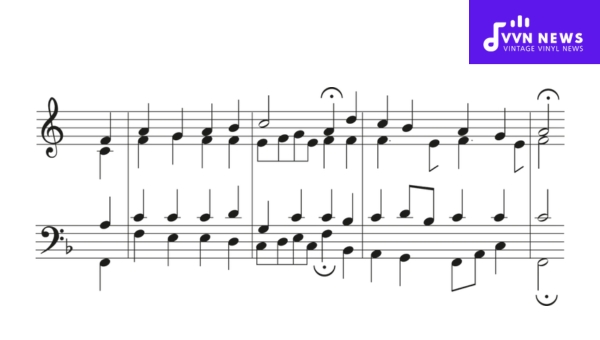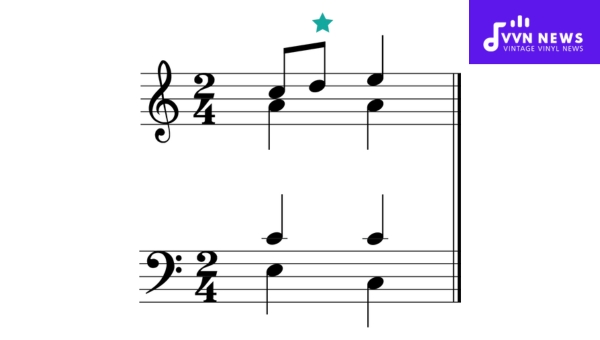Music has the power to resonate within us, evoke deep emotions, and create unforgettable experiences. The beauty of a melody is often embellished by something special known as melodic decoration.
It’s like the secret ingredient that accentuates a dish and makes it even more delectable. Melodic decoration serves as an intricate weaver of stories—a skillful, subtle way musicians use to breathe new life into their compositions.
Exquisite notes are scattered throughout melodies like pearls, transforming a simple harmonic rhythm into something much more elaborate and rich.
If you’ve ever marveled at the complexity of a piece or been deeply moved by its intricacy, chances are, you’ve experienced the allure of melodic decoration firsthand.
What Are Melodic Decorations?
Melodic decoration, sometimes also referred to as non-harmonic tones or non-chord tones, adds intricate details to musical compositions.

They are essentially additional notes that deviate from the primary theme but enhance the overall melody by creating tension, contrast, and a rich texture.
The clever use of these ‘decorations’ in a tune can evoke profound emotions in listeners, provide interesting variations to an otherwise simplistic piece, and elevate the entire musical experience.
Every genre – be it a classical symphony or jazz improvisation – appreciates and integrates these nuances to enrich its symphonic expressions.
In essence, they’re ornamental flourishes that add depth and complexity to a melody.
Also Read: E Major: Scale And Chords [Exciting Sounds For Your Compositions]
The Seven Different Melodic Decorations
Music, at its heart, tells a story, and like any good narrative, it benefits from a bit of adornment.

These enhancements are more than just frills — they are the building blocks that shape and inform the melody.
Let’s delve into seven types of melodic decorations that not only add beauty but also depth and complexity to a composition.
Passing Notes
Encapsulating the spirit of melody and rhythm, Passing Notes stand as one of the most vital elements in the world of music. They operate by linking two non-consecutive notes, with a note or sequence “passing” through them.
It’s astounding how these “travelers” augment the richness of a tune. Let’s further unravel the beauty and complexity of Passing Notes. Primarily, Passing Notes act as connectors, filling gaps between two melodically essential notes.
These notes might seem insignificant but possess great impact; they facilitate a smoother transition, thus contributing to a graceful musical flow.
The passages between notes get decorated, facilitating continuity and reducing jarring leaps within melodies. Furthermore, there are both diatonic and chromatic passing notes at play. A diatonic passing note falls within the key signature; it adheres to the scale structure.
In contrast, chromatic passing notes employ semitone steps which do not necessarily conform to the scale structure.
In terms of placement, Passing Notes can appear anywhere: onset or conclusion of a phrase or right there in between, inducing an effect reminiscent of syncopation.
Auxiliary Note
If Passing Notes serve as filling agents within a melody line, Auxiliary Notes function as decorators adorning their adjacent principal notes.
Auxiliary Notes (also known as neighbor or buddy tones) occur when you start with a main note (often called a chord tone), move up or down by step to another note (usually non-chord tone), and then return to your original chord tone.
In essence, these decadent decorations play around their primary notes- higher (Upper Auxiliary) or lower (Lower Auxiliary). They generate tension by deviating from the home pitch but promptly return for resolution.
It’s remarkable how swiftly auxiliary notes retrace their steps, creating dips and spikes in melodic texture without straying far from home. They provide brief but essential melodic detours that add to the multi-dimensional aspect of a melody.
While considered non-essential to the harmony directly, their role in embellishing and shaping a melody remains unquestionable. Like shiny baubles adorning a festive tree, Auxiliary Notes breathe life into music.
Whether it’s the graceful dosey-doe between notes via passing tones or the playful dance around primary notes with auxiliary tones, melodic decoration undeniably possesses an enchanting allure all of its own.
They’re a testament to how complexity can be painted using simple strokes and imbue richness within seemingly modest melodies.
Changing Note
A changing note more commonly known as the neighboring tone, adds vibrance to a melody by briefly shifting the rhythm before returning to its original note.
It serves as a complement, an unpretentious deviation that adds a refined layer to your music. Here’s how it functions. You begin with a primary note. Say, for instance, it’s ‘C’.
You then proceed to include a changing note, let’s say ‘B’, and later revert to your initial note ‘C’. The pattern becomes C-B-C.
Pay attention though! A changing note isn’t just any other note picked at random. This unique melodic decoration is usually within stepwise motion from the melody.
Keep in mind that when implementing this musically expansive device into your compositions, context matters!
It’s like adding spices to your meal – understanding how much or how little depends on the composition you’re aiming to create.
Anticipations
In contrast to changing notes, anticipations create an element of surprise which contributes significantly to the overall aura of a musical piece.
Who doesn’t enjoy an unexpected twist in a good book or movie? Anticipations provide that same thrill within the music. Anticipation in music occurs when a specific melodic tone is introduced sooner than expected.
This can be achieved either rhythmically or harmonically – by playing the subsequent chord’s tone before it appears contextual with your composition.
The logic behind anticipations lies in playing off against our innate anticipation of musical progressions making it quite an audacious and interesting technique.
For instance, consider you’re working on a progression from a C major chord (C-E-G) moving toward F major (F-A-C). The ‘C’ from F major may be anticipated and played within the time slot of the C major chord itself, setting up an interesting musical taste.
Both changing notes and anticipations, though seemingly minor in the grand scheme of melodies, carry an enormous potential to power up your music, transforming it into a masterpiece.
Suspensions
Suspensions offer a beguiling twist to the melody. They are characterized by deliberately delaying the resolution of a note, creating a tension that sways between discomfort and anticipation.
This delay tantalizes the listener, creating an expectation for resolution and making the eventual harmonic endorsement profoundly satisfying.
To elaborate, if in a particular chord progression, you identify a note that elicits tension (this is usually from the chord before), yet resolves soon after, this is likely indicative of suspension.
It’s the artful dance between tension and release that essentially augments the emotive allure of a piece.
Retardations
Retarding notes works on an almost seemingly objective contrary to suspensions. Retardations involve elevating instead of deferring the resolution note about its melodic chain.
With retardations, anticipation is raised before it ultimately subsides when an elevated, suspenseful note finally arrives at its destined point as per consonance with other notes within its harmonic system.
Imagine being on top of a peak; you know there’s only one way to go: downwards.
You’re anticipating your descent—this feeling resonates with retardation in melodic decoration terms. When effectively utilized, retardations can deliver profound emotional resonance within melodies.
This technique transforms potentially mundane scales into fantastic narratives blooming with emotion—stories told not through words but through harmonic resonance.
Pedals
Then we arrive at pedals or pedal points—a metaphorical anchor keeping other changing notes grounded within its harmonious grasp.
Often found either at the beginning or end of phrases (and sometimes both), they provide stability amidst change–much like the North Star guiding us amidst astral fluctuations during nightfall.
In music theory jargon, pedal points are defined as sustained tones throughout changing harmonies or chords—a constant thread reinforcing continuity while other notes flexibly morph around it.
Consider it as a background drone note underpinning a melody. It’s this consistency that encases the musical composition in a wrap of cohesive magnanimity.
While pedals are generally characterized by their omnipresence in a phrase, they aren’t necessarily uniform.
You will often find instances where pedal points momentarily tune out – only to re-emerge, or simply ebb and flow discreetly within the bounds of melodic ornamentation.
These elements of melodic decoration are not merely fanciful additions; they have a profound impact on how we perceive and feel the music, with potential effects ranging from subtle enhancement to radical transformation.
And it’s these decorations that transform an artist’s creation from mere sound into stories—extraordinary narratives that captivate listeners and leave them yearning for more.
Also Read:F Sharp Major Triad [Enhance Your Musical Compositions]
FAQs
What is a melodic decoration?
A melodic decoration is an embellishment or enhancement of a melody that adds complexity and depth to a music piece.
How is a passing note used in melodic decoration?
A passing note serves as a decorative, transitional note moving stepwise between two primary pitches.
What does an auxiliary note contribute to a melody?
An auxiliary note contributes to the variation of melodies by providing small detours from the main pitch before returning.
Can you explain what suspensions are in terms of melodic decoration?
Suspensions are essentially harmonious “hangovers,” where a note from a previous chord lingers into the next chord, serving as tension before resolving.
How does using retardations impact melody intricacy?
Retardations delay resolution, adding unexpected elements that surprise listeners and enhance engagement.
Also Read: A Minor Scale [Unlock The Mysteries Of Musical Composition]
Conclusion
It can be said that melodic decoration fundamentally enhances the auditory experience. Whether it’s a passing note, an auxiliary, or a changing note, these decorations brilliantly weave into the musical fabric, creating a distinctive musical landscape.
Anticipations, suspensions, and retardations provide tension while pedals ground the piece, offering a harmonious balance.
In practicing and mastering these decorations, one can truly appreciate the intricate beauty of music and perhaps even use them to enhance their musical compositions.








